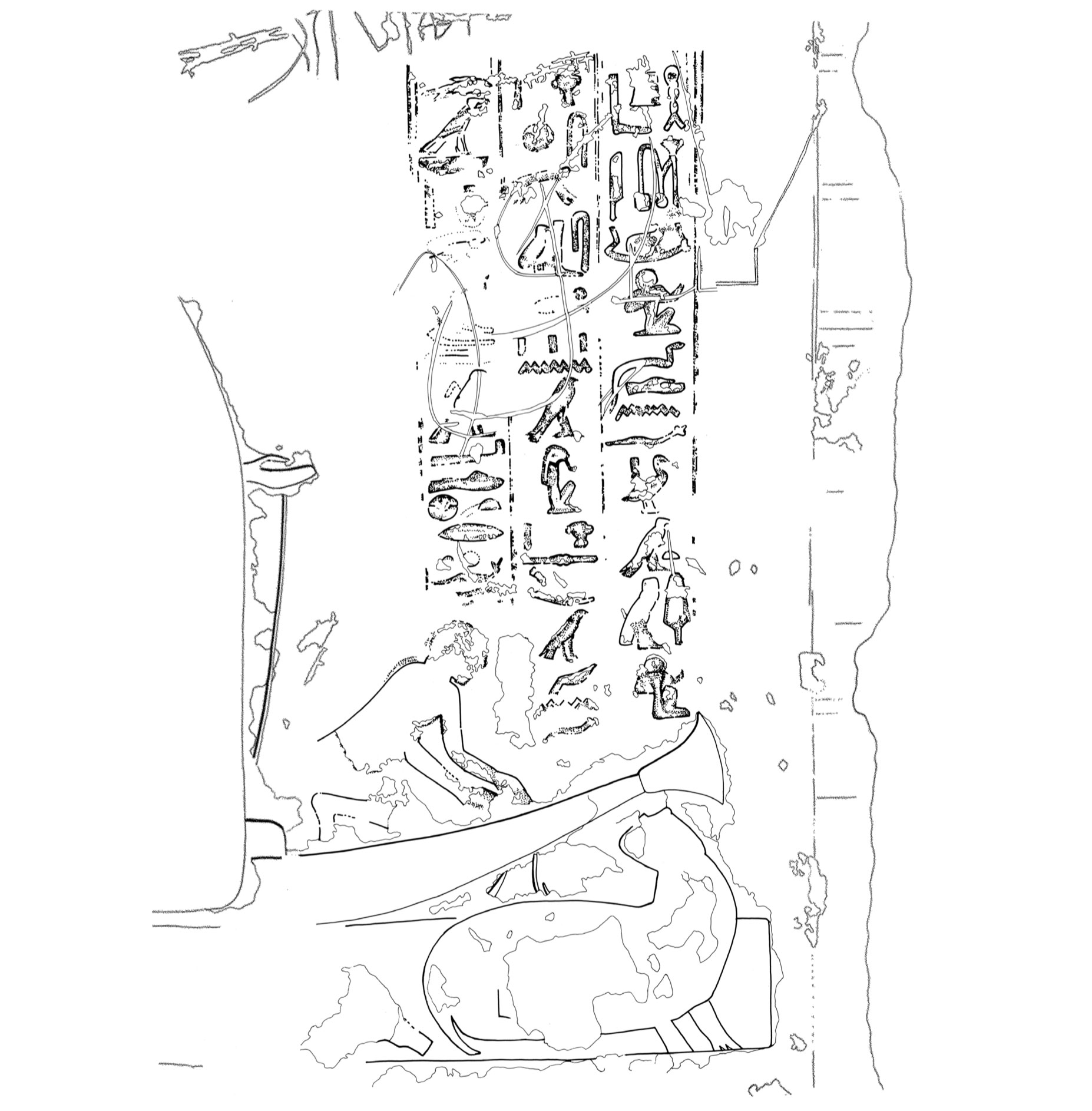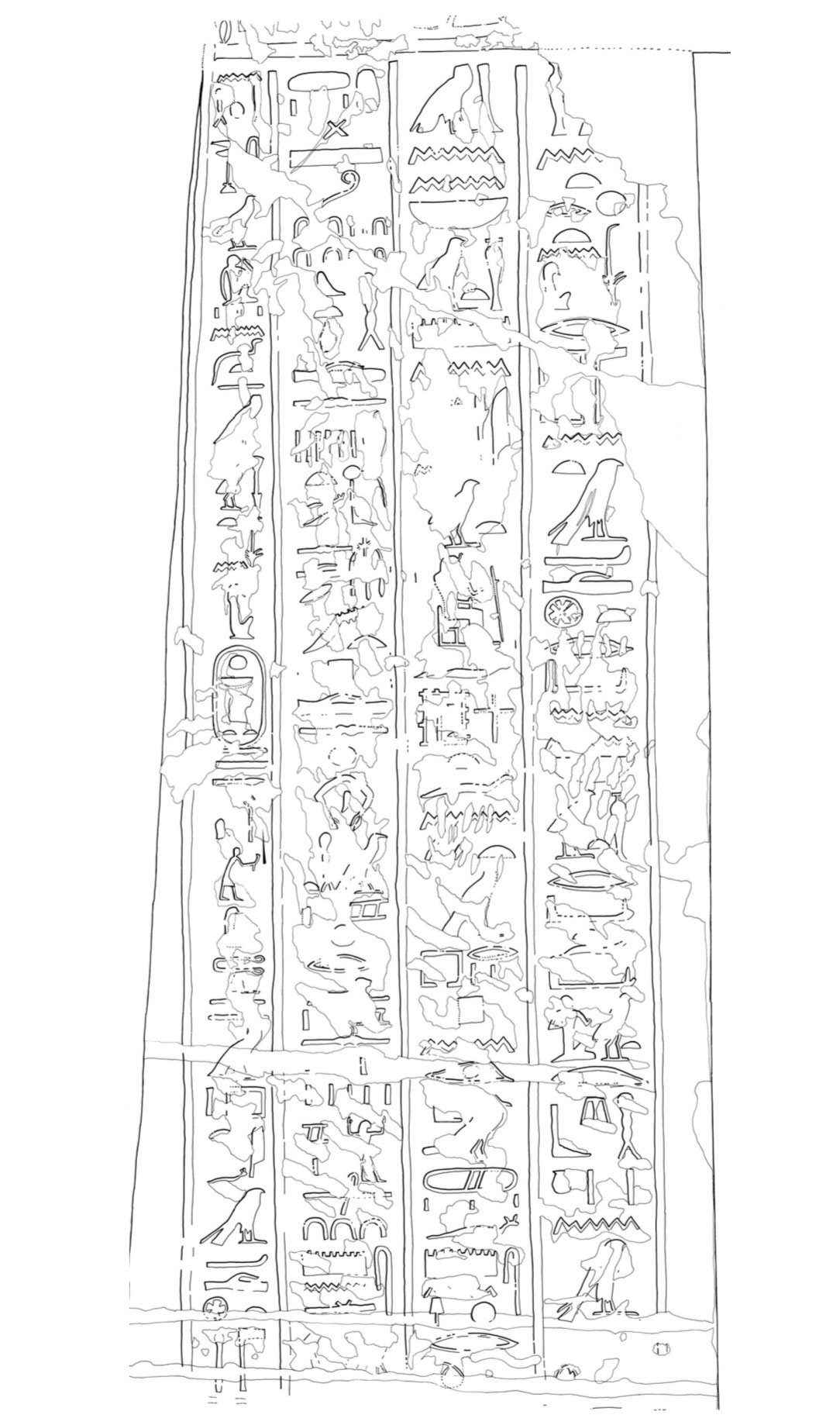The Tomb of Sataimau at Hagr Edfu

Hagr Edfu from the north, with the modern monastery at the foot of the main hill (Photo: W. V. Davies).
Project description
A British Museum expedition has been working at the necropolis of Hagr Edfu under the direction of W. V. Davies since 2001. In recent years, the expedition has documented a group of three tombs at the foot of the main hill of the site, originally uncovered by the Egyptian Antiquities Service in 1941. One of the tombs belongs to a high official named Sataimau (HE Tomb 1, Area 3) and is dated by inscription to the reign of King Amenhotep I. The two others were left undecorated by their original owners but bear a large number of secondary motifs and inscriptions.
Decorative program
“The main focus of our epigraphic work has been HE Tomb 1. It is unique in being the only pharaonic tomb yet uncovered at the site which bears its original decoration. Moreover, it dates from a period, very early Dynasty 18, from which few securely dated tombs have survived anywhere in Egypt.”
“The tomb-chapel was hewn out of a stratum of soft sandstone which contained numerous faults and fissures. In the preparation of the walls for the artists, these imperfections were filled in with thick white plaster to create an even surface. A thin wash of plaster was then applied, which served as the ground for preliminary drafting, with preparatory squared grids in red used selectively. The final decoration was executed first in pure paint with certain scenes, in particular those depicting the primary figures, subsequently worked in sunk-relief, with raised relief used to model details within the sunk-relief figures, the relief was then painted. Raised relief was used to render the outline of a major figure only once, on the facade. Work on the tomb was well advanced but not completely finished. The decoration is now much damaged and paint, where it survives, is mostly very faded.”
The east wall of the first chamber “bears a number of hunting and fishing scenes, with the two major scenes placed apotropaically on either side of the entrance… The main scene to the south of the door shows the tomb-owner standing in a papyrus-boat harpooning two fish, accompanied by his wife and daughter, both named Ahmose, and a son named Amenhotep.
The equivalent scene to the north shows a hippopotamus-hunt (Fig. 9). Of the figure of the tomb-owner, only the front hand survives holding a rope once shown as attached to a harpoon now missing. Before him is a kneeling attendant. The quarry, a large hippopotamus, with head turned backwards, is depicted in the water beneath the front of the boat, held fast by ropes and the butt of a harpoon.”
“The niche façade is decorated with three sets of inscriptions (all deliberately damaged,
but still legible): one on the lintel, comprising two horizontal lines, and one each on the left and right jambs respectively, arranged in four columns… The inscription on the left jamb is a biographical text (Fig. 18)… one of the earliest ‘autobiographies’ of Dynasty 18, records that King Ahmose twice favored the tomb-owner with professional advancement.”
Documentation method
Not specified by the author.
The core epigraphic team in the Tomb of Sataimau comprised Vivian Davies, Marcel Marée, Ilona Regulski and Claire Thorne, who has also prepared drawings for publication. Additional assistance has been provided by Renée Friedman, Sabine Kubisch and Will Schenck.
Visual example(s)
Fig. 9: HE Tomb 1, east wall, left, detail of hunting scene (click to enlarge).
Fig. 12: HE Tomb 1, north wall, section of frieze-inscription (click to enlarge).
Fig. 18: HE Tomb 1, niche-façade, left jamb, inscription (click to enlarge).

Fig. 10: HE Tomb 1, north wall, left (Photo: Y. Kobylecki).

Fig. 23: HE Tomb 1, niche interior, north wall, inscription as recorded on transparent acetate (Photo: W. V. Davies).

Hagr Edfu, Area 3, collation of inscriptions, pottery drawing and measuring elevations in Tomb 1 (Satamaiu, above) and cleaning and recording of inscriptions and motifs in Tomb 3 (below) (Photo: James Rossiter).
What we like
- Carved remains of the decorated surface are presented within the boundaries of the generally accepted sun-shadow conventions, applied consequently and consistently throughout the entire documentation material.
- Damage outlines, although thoroughly indicated over the entire decorated area, are shown in a very subtle manner by using thin, light-gray, single weight lines.
- In certain occasions, weathered surface is indicated by a dotted fill. These specific cases refer to decorative elements that aren’t present anymore, due to the disappearance of the weak filler material used to cover the imperfections of the wall surface (Fig. 12).
- Faded and fragmentary painted remains, such as preliminary sketches, preparatory grids etc. are presented with thin, single-weight outlines as long as their features can be safely determined.
- Graffiti are indicated with thin, single weight outlines as part of the complete facsimile drawing, displayed at their original occurrence on the wall. (Traditional Rapidograph ink drawing on paper.)
Additional reading
For the original context of the material appearing in this article see:
and
To read more about this expedition as well as the British Museum’s other research projects, visit their website.
Précis and commentary by Júlia Schmied






1 comment(s)
Vivien Raisman
Jan 3, 2019Delighted to have these available as I can hardly climb up to the tombs any more. I particularly like Khnumhotp II.

Jan 5, 2019Dear Vivien, thank you very much for your kind words and your interest in our Reading section! We are planning to add as many relevant documentation projects to our corpus as possible, so stay with us in 2019!
Leave a comment(We'll keep your email address private)